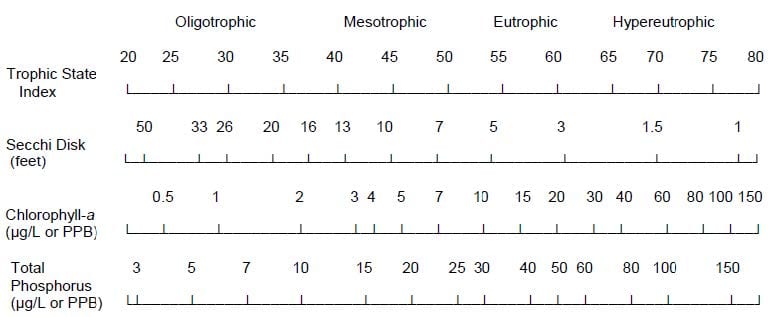I hope you read the recent blog article Lake Maxinkuckee’s Annual Check-Up. I wrote about Indiana University’s Clean Lakes Program and revealed Lake Maxinkuckee’s Carlson’s TSI score – putting us in between Oligotrophic and Mesotrophic. I also posed the question:
Is the Trophic State Index, or TSI, of Lake Maxinkuckee getting better or worse?
I was able to spend some time looking through historical data and here is what I found:
2005 – What is the Trophic Level this year?
Secchi Disk Trophic State Index (TSI) 47
Chlorophyll-a Trophic State Index (TSI) Value 46
Total Phosphorus Trophic State Index (TSI) Value 55
2018 – What is the Trophic Level this year?
Secchi Disk Trophic State Index (TSI) 48
Chlorophyll-a Trophic State Index (TSI) Value 41
Total Phosphorus Trophic State Index (TSI) Value 36
2020 – We already determined Low Oligotrophic/High Mesotrophic
Secchi Disk Trophic State Index (TSI) 45.95
Chlorophyll-a Trophic State Index (TSI) Value 41.70
Total Phosphorus Trophic State Index (TSI) Value 38.73

Based on this information, I can say the Trophic State Index (TSI) of Lake Maxinkuckee is relatively unchanged for the past fifteen years – solidly between Oligotrophic and Mesotrophic. Not a bad place to be.
I also found a hard copy report “Indiana Integrated Water Quality Monitoring and Assessment Report” dated September 24, 2002 which lists Lake Maxinkuckee’s Trend as “Stable” and the trophic status as Mesotrophic. I then looked up this same report online for 2020 and the result is the same: Stable and Mesotrophic. These two analyses support my conclusion that Lake Maxinkuckee has been holding steady for at least two decades.
But lest we get complacent, according to a “Determining the Trophic State of Your Lake” even relatively minor changes in land use can have a profound effect on the trophic state of a lake. That is one of the reasons LMEF fought the change this year in Indiana Law removing wetland protections. Even though the three wetlands immediately adjacent to the lake are federally protected, there are many more wetlands in the watershed that are now NOT protected. What impact might their elimination have on the water quality in Lake Maxinkuckee? Only time will tell.
LMEF will continue with research, education and outreach and hope that in 2051 and beyond, Lake Maxinkuckee will consistently be Stable Mesotrophic or better yet, improving.
SLOW AND STEADY WINS THE RACE.

Hi, I’m Debbie Palmer. I received a BS in Horticulture from Purdue University. Here at LMEF, I am responsible for outreach presentations, monitoring the lake and it’s wetlands, project manager for restoration and research projects, and act as a community resource for all things related to the well-being of Lake Maxinkuckee and its surrounding watershed. I completed Indiana Watershed Leadership Academy, volunteer with the Indiana Clean Lakes Program, Hoosier River Watch and Marshall County Lakes and Waters and serve as a Board Member for Indiana Lakes Management Society.


Recent Comments